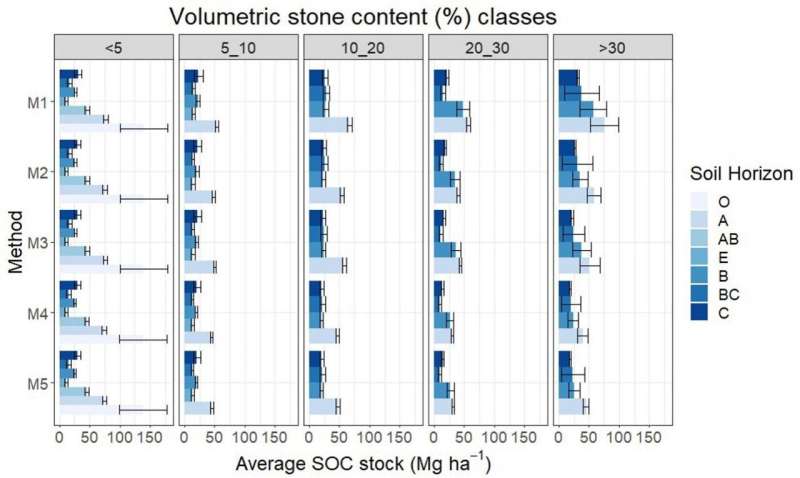This article has been reviewed according to Science X's editorial process and policies. Editors have highlighted the following attributes while ensuring the content's credibility:
fact-checked
proofread
Assessing soil carbon stocks accurately

Researchers from Teagasc have published an article in Geoderma Regional highlighting the consequences of not measuring soil organic carbon (SOC) stocks in Irish grassland soils precisely. Quantifying changes in SOC, either carbon sequestration or losses into the atmosphere, requires accurate determination of soil bulk density, which is only achieved by accounting for soil stone content (rock fragments higher than 2 mm in size).
The research by Professor Owen Fenton and colleagues highlights the critical importance of soil bulk density estimations for SOC stocks, particularly in Irish grassland soils, which can have relatively high stone content. Stones (i.e., rock fragments higher than 2 mm in size), which ranged in content from 0% to 36% in the soil horizons examined, are mainly inert and do not interact with soil organic matter, but have a much higher density than the active part of the soil. So if stones are not discounted from SOC stock calculations, it can lead to gross overestimations of SOC stocks.
Fenton, principal research officer at Teagasc Johnstown Castle said, "To fully understand soil organic carbon dynamics, especially in the context of Irish grassland soils with variable stone contents, we need accurate methods for determining bulk density. Stones are often incorrectly accounted for in bulk density calculations and can lead to overestimation of soil organic carbon by 18%–388%. Accurately measuring soil organic carbon and carbon content changes in soil over time requires more than the measurement of soil organic carbon concentration."
Teagasc evaluated five commonly used calculation methods and compared the resulting SOC stocks using data archived within three prominent soil databases, including the Irish Soil Information System (I-SIS), the Heavy Soils Program (HSP), and the Soil Quality Assessment Research Project (SQUARE). Methods for measuring bulk density that do not break field-dried samples into fine (less than 2 mm) and coarse material (above 2 mm) through arduous sieving, overestimate SOC stocks by as much as 388%, whereas those methods that factored in these components were closer to reality.
Dr. Karl Richards, head of the Teagasc Climate Center, said, "This Teagasc research underlines the importance of robust, reproducible and accurate methods to measure, report and verify soil organic carbon stocks on Irish farms."
These findings offer valuable insights for policymakers, agricultural practitioners, and environmental scientists seeking to enhance the accuracy of SOC stock assessments in grassland soils. Dr. Karen Daly, Acting Head of Environment, Soils and Land Use Research Department in Teagasc, said, "This work provides a protocol for implementing best practices in measuring bulk density for carbon stocks, and will minimize uncertainty and give confidence to the soil organic carbon stocks calculated for future carbon farming schemes."
More information: O. Fenton et al, Relative and absolute difference in soil organic carbon stocks in grassland soils in Ireland: Impact of rock fragments, bulk density and calculation methods, Geoderma Regional (2024). DOI: 10.1016/j.geodrs.2024.e00769
Provided by Teagasc




















